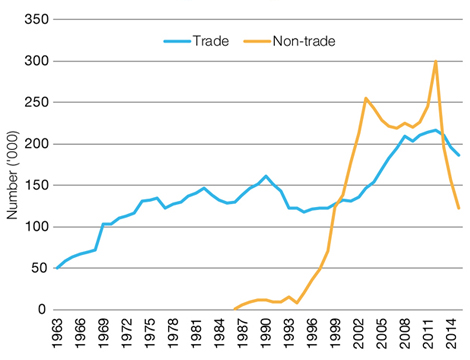In this section we explore stories of how a regulatory body is destroying Australia’s education and training sector, the livelihood of people and causing immense stress and loss to the individuals working in the training organisations.
Our first guest in this series is Brett Hilder.
Brett Hilder is a businessman with extensive experience drawn from his creation of a national training company and is able to bring together an understanding of the urgencies of commerce together with an appreciation of the priorities of public agencies.
In the past he has been able to negotiate positive changes in public policy, government agencies and procedures through the incisive understanding of relevant key issues, and a proper insight into the public sector approach. For example, he played the key role in convincing the Australian government to conduct a review of federal agencies through public advocacy during the period 2012 – 2015. This resulted in major reforms to the regulatory environment in the Vocational Education and Training (VET) industry.
In addition, working directly with large corporations over the last 25 years has provided him with a valuable understanding of how they interact with small and medium sized enterprises (SME’s).
He has written two books on time management and workplace productivity, delivered keynote addresses and run seminars on business development, productivity, leadership and advanced negotiation strategies. High level one-to one coaching, hands on skills training in the general workplace and in the health sector specifically, have seen over 2000 people acquire skills and knowledge which enabled them to excel in their chosen professions and attain jobs.
Brett is ready to assist organisations arm themselves properly to enable them to address concerns in public administration in order for them to protect their rights, title and interests in their respective businesses. He is also a lobbyist listed with the Australian Federal Government and a member of the VET Reform Now network.
Q: Brett, can you please tell us something about yourself, your background and what you do?
I’m a businessman at base level having grown up a third-generation farmer. Agriculture seems a long time ago now, however it instilled in me a fundamental understanding of the robust and honest demands on the individual of business reality. That is, results count, and you succeed or fail on your own merits, even though elements such as the weather for example, are beyond human influence.
I first established my own business, a small management consultancy, in Perth in the mid 1990s focusing on time management and workplace productivity for individuals and organisations. I wrote two books on the subject and was deeply immersed in this area for several years.
Q. What drew you into training for the health industry?
I had a motorcycle crash in 1999. Unable to continue the paid work I was doing while my consultancy established a secure income stream, I completed a nurse assistant training course, and for a short time worked in this role. The consultancy grew though, and I was able to focus full time on developing it after only a few months, nevertheless I learnt a hell of a lot about basic patient care.
My ex-wife is a registered nurse and it seemed worthwhile at the time to develop a training course for nurse assistants suitable for hospital and aged care at cert three-level. It took twelve months of hard work and in August 2001 we ran our first
course. It was oversubscribed with 26 students, but we made it work and nearly all were successful. Every graduate got a job immediately and the work experience employers we worked with were delighted and we were off and running.
Q. How did it go?
In 2003, my company amended scope and was able thereafter to issue the nationally recognised Certificate III qualification for Patient Care Assistants under the WA jurisdiction (TAC). Through 2008-2009 we expanded from WA into Victoria, New South Wales, South Australia and Queensland. The workload was immense of course, but extremely rewarding. Our reputation amongst employers and students was I believe, second to none. By 2010, we had already received two letters of commendation from TAC for our levels of compliance and innovation.
ASQA, as you know, destroyed everything in 2011-12. In the seven years since, I have been working hard to drive real VET reform. During the same period, I have had 15-17 months paid work.
Q: What are your experiences dealing with the current national VET regulator?
It can be summed up by the first ever contact we had from ASQA dated September 2011: A letter of intention to suspend our registration, with just over two days to respond.
This was the result of a secret desk audit, conducted on incomplete site audit documents against the old standards conducted by the state regulator, TAC. We hadn’t even received the mandatory Certificate of Registration as an RTO under ASQA, which itself is a breach of the NVR Act.
It was a hostile attack utilising faulty data while breaching the very laws the regulator was charged with upholding. It went downhill from there.
We were subject to a highly prejudicial audit process, a cut in funding support to the 20% of students we were training who were relying on it, ordered not to supply compliance documents to the auditor, a refusal to engage with us on rectification or clarification of our levels of compliance and factually incorrect assertions of complaints and risks against my RTO by the Chief Commissioner, Christopher Robinson and Assistant Commissioner Dianne Orr.
Of course there was a blanket refusal to take into account or even acknowledge the outstanding reputation among industry stakeholders and 7000 students we had built over a decade. ASQA used it’s lawyers to attack my company at every opportunity.
Q. What do you believe were their motivations for this behaviour?
The national VET regulator was clearly going after us because for base political The national VET regulator was clearly going after us because for base political reasons: so that it could demonstrate it was a ruthless regulator, regardless of the true level of our compliance. We were fully compliant. Looking back, this tactic was all ASQA had, because then, as now, it did not understand training, it did not understand assessment and it did not understand compliance. My company however, did understand all of these matters having worked through the turbulent and ever changing regulatory environment of the preceding decade.
Q: What did you do to get justice and how was your journey?
Everything short of taking ASQA to court. The nature of the way ASQA ‘audits’ private RTOs cripples the income stream and this in most cases ensures the RTO can no longer fund the $250-300,000 necessary.
What ASQA did not know, was that at this time my girlfriend was an experienced senior corporate lawyer. In one weekend, she and I discovered the first 23 breaches of the NVR Act by ASQA in dealings with my company. We also uncovered another 20+ instances of abuse of process and breaches of procedural fairness (rules of Natural Justice).
I was the first to take ASQA to the Administrative Appeals Tribunal on July 2-4, 2012 but they could only look at compliance against the original woefully nebulous standards for RTOs. (Even after 2015, they are still open to interpretation in order to be applicable to all training). Against ASQA’s legal team and their illegitimate tactics, I lost the case because of interpretations of compliance. The AAT however, found that my company was. “…a training provider of quality.”
None of the breaches in law and abuses of process by ASQA were considered by the Tribunal.
Still seeking justice, requesting documents under the FOI Act turned out to be a slow pointless exercise, and even lawyers now will have no success in getting the documents you are entitled to, due to the cop-out provisions built into this now largely worthless piece of legislation.
You are advised to be patient and trust the process. Ignore this advice. Here’s why:
Step One: You complain to ASQA. The regulator, eventually, tells you nothing was done incorrectly with regard to your case. Not satisfied, you go to
Step Two: Lodge a formal complaint with the Commonwealth Ombudsman. However, they advise they cannot investigate your contentions because it would only have been possible at the immediate time.
Step Three: You request documents under FOI from ASQA, but receive only 25% of those requested due to the cop-out provisions built into this now largely worthless piece of legislation. The docs you do get contain only administrivia. Then follows:
Step Four: You request a Freedom of Information dispute resolution to obtain the docs from ASQA, this time through the Office of the Australian Information Commissioner.
You are advised you must wait a year for an officer to become available and conduct the review. (The I-C is under-resourced owing to the upsurge of cases where government agencies refuse FOI requests).
The Commonwealth Ombudsman is impotent.
I discovered secret reports with recommendations about your RTO’s matters, including their advice regarding compensation, are provided by ASQA to the Minister. You make an FOI request to ASQA to acquire copies of these reports and end up repeating Step 3 and Step 4.
Transparent government is a myth when it comes to matters of justice where a bureaucrat is culpable.
The only opportunity for restorative justice for someone in my position is the CDDA Scheme (Scheme for Compensation for Detriment caused by Defective Administration).
In the end, 51 breaches of the NVR Act and procedural fairness by ASQA were identified and these formed the basis of my claim for compensation. In a process designed to fail the applicant, my claim was rejected out of hand because it can only be assessed by the offending government agency, in this case, ASQA. All I got was a one-pager stating ASQA did everything right. It is a joke.
The CDDA Scheme on the face of it is a fair option for compensation, however in practice, it seldom works because of the conflict of interest built into the process. A decision does not have to be made based on court-of-law proof, weight of evidence or even balance of probabilities, rather that a reasonable person in possession of the relevant information forms the view that wrong has been done to the individual or organisation. In practice, the CDDA Scheme was put in place by politicians only to be abused by bureaucrats.
Despite requests, I was never granted a meeting with any Minister, however I appealed through his office a few times. All they did was ask ASQA for their opinion who in turn provided him with false advice, and my claim was rejected without explanation again. I have requested that succeeding Ministers properly review my claim but none have, and all have simply responded with one-pagers claiming ASQA did everything right. To this day, not one of my 51 contentions of defective administration by the regulator have been answered.
Justice delayed is justice denied and I’ve been trying and waiting for nearly eight years so far.
Having nothing to lose as of 2012, I committed myself to transparency and investigation of ASQA along with additional true reform of VET. This formed part of the strategy for compensation for my family as I became aware there was no viable process to receive justice and no good-will in government to restore what it had taken from us.
Q: I have heard several times before this interview that you have lost a lot because of ASQA, can you please elaborate what, why and how for us and our readers?
I lost my livelihood and everything else: Family home, cars, business, two new investment properties which were going to help provide security for everything, superannuation and my reputation (because ASQA makes its decisions public). Forced into bankruptcy (Fairfax media unpaid account of $6800) and suffered significant damage to my health also for my trouble.
It’s probably not a good idea to borrow money against the equity in your family home to fund business growth or development if you’re in ASQA’s jurisdiction. Looking back, one thing I would do differently is use trusts to provide some security, at least against the thugs.
Problem is, we were going through significant, planned, growth. Despite the usual inherent challenges, it was working well and our quality was never compromised, however unless you are debt free and holding a significant war chest of funds, ASQA simply abuses its powers to cut off an RTOs income stream indefinitely, forcing its liquidation. That is what happened to my company.
Q: Where do you think the ministers are failing to protect Australian education and training businesses?
-
The majority have been captured by ASQA. This the fault of the ministers themselves.
-
They have been too afraid, or too willing to believe ASQA, to conduct a parliamentary inquiry or Royal Commission into the regulator.
-
There has been an utter failure to decisively act on the concerns, experiences and information provided by SME RTOs.
-
Ministers conflate the wrongdoing of a small number of cashed-up, lawyered-up ghost or very large RTOs, with the quality training delivered by the 4000+ SME RTOs.
-
They put too much store in the opinions of the large vested interests that make up these more-of-the-same ‘consultative’ committees.
-
The Prime Ministers thus far have shuffled countless different ministers through the VET portfolios so that they never wind up getting to grips with a very complex and difficult sector. Permanence is power. Impermanence is impotence.
-
Ministers have failed to investigate ASQA fully, abolish it and replace it with a fit-for-purpose regulator staffed by different people working to an ethical, transparent public service culture; if such a thing still exists.
Note: The views and information provided in this article are independent views of the guests. Career Calling, CAQA or any of our staff members may not share the same views or thoughts.
Would you like us to interview you for this series? Contact us today at info@caqa.com.au.




















